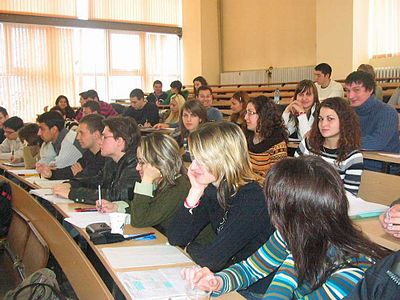Circuit Idea/Joining Students of TU Sofia
Conceiving the idea
[edit | edit source]In the beginning of March, 2008 I decided to join my students to Circuit idea. I started this initiative "in sport" but it turned out so successful and exciting that I was entirely absorbed in this new web undertaking. I have told how it started in the discussion of the first completely finished page that my students and I have dedicated to the famous Ohm's experiment.
Situation
[edit | edit source]During the summer term, 2008 I was teaching basic circuitry (both lectures and laboratory exercises) to 150 students from Faculty of Computer Systems, Technical University of Sofia. They were divided into five groups (64, 65, 66, 67, 68), each of them containing 30 students.

Further, for the purposes of the laboratory exercises, these groups were divided into sub-groups of 15 students. Each laboratory cycle was lasting two weeks: the first five sub-groups (64a, 65a, 66a, 67a, 68a) conducted laboratory exercises during every even week; the other five sub-groups (64b, 65b, 66b, 67b, 68b) conducted laboratory exercises during every odd week.
Preparation
[edit | edit source]First, in the lecture hall, I announced my intention to conduct such a web experiment to students and showed them how can we carry out it. I told them what is the great Wiki idea and how they can join the wikibook Circuit Idea. I suggested to students to choose meaningful user names consisting of student name and group number (thus I can observe their web achievements and add more credits to the rating).
Then, I created separate pages of all the ten student groups (64a, 65a, 66a, 67a, 68a, 64b, 65b, 66b, 67b and 68b). In these group pages, my students and I, all together, were placing what we had done in the laboratory and the lecture hall - photos, drawings, texts, etc.
I also prepared all kinds of recording equipment - a small solid state recorder (for quite a while I was recording my lessons, classes and laboratory exercises), camera and mobile phone. I even thought to install a web camera.
Implementation
[edit | edit source]In the student group pages, my students and I were describing step-by-step how the laboratory exercises had passed. The great mass of the written was extracted from the records but there were also some fragments written directly to this page in the laboratory during the exercises. Note that students were making their reports in real time at the laboratory; I was making also my "report" on the white board (ten times during the cycle!), snapping it from time to time and writing it on the according page. Students and I were making a lot of photos during the exercises. These photos show drafts on the whiteboard, screen shots, laboratory setups and, of course, the very students.
The idea was first to write up in talk pages chronologically what was done in the laboratory; then to systematize and polish these raw materials and place them in the main story. We were using here a quite informal style. I was marking student's insertions by italic to distinguish them from my teacher's text.
Thus, during labs and lectures I was recording our conversations and discussions by the solid-state recorder and making snaps by the digital camera; some students were doing the same. The photos were drafts on the whiteboard, screen shots, laboratory setups, the very students (and sometimes, their teacher:), etc. On returning at home, I was downloading the records and pictures to my computer and began processing them. In order to help students, I was outlining briefly the structure of the future modules in the student and talk pages; then I was placing all the raw materials (pictures) in the pages. I also was adding links to useful resources and some provoking questions. Then I was leaving students go on developing the stories; I only was intervening in their works from time to time to edit and refine them. Finally, I was expanding student works by adding more explanations and using these materials to create the according modules.
You can see how I placed (on the right) links in the list of started circuit stories pointing to the corresponding student pages.
I also invited some famous web writers (mainly, university and college teachers) to join our educational web initiative - Tony Kuphaldt (Lessons in electric circuits), Tom Hayes (Student manual for the art of electronics - great book!), William Beauty (Science hobbyist - great site!).
Results
[edit | edit source]You can imagine how powerful this approach was where students and their teacher, all together, were working on the same common project! They were adding, editing and continuously refining it; they learned how to present what they have done to other, how to contribute a wiki project, how to communicate with people, etc. Furthermore, any web visitors (including other students and their teachers) through the world could join and enrich this open project! It was just wonderful!
